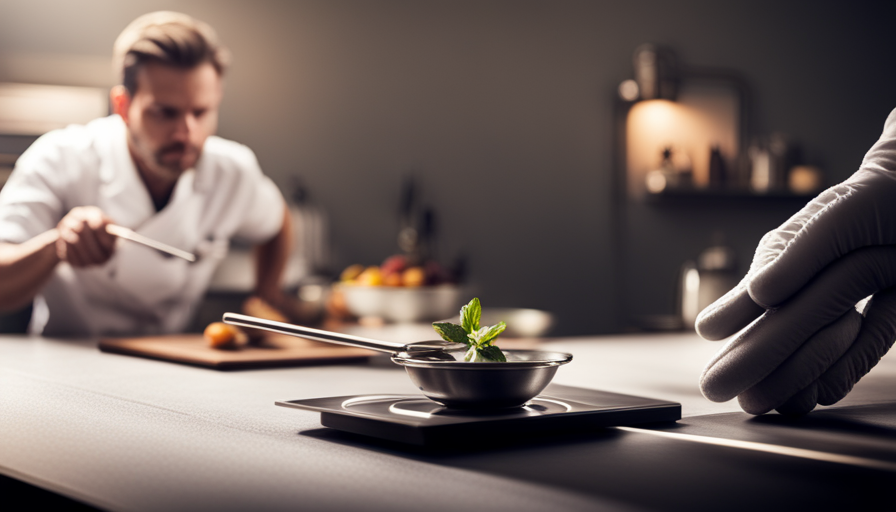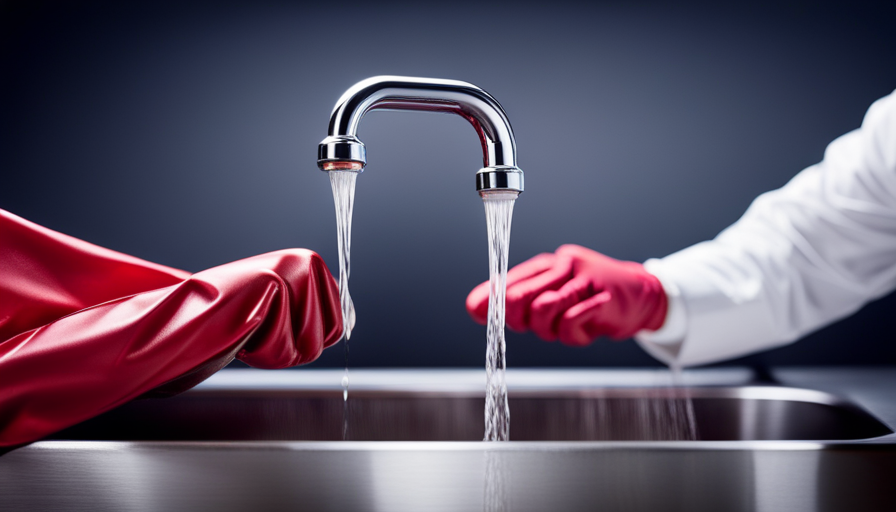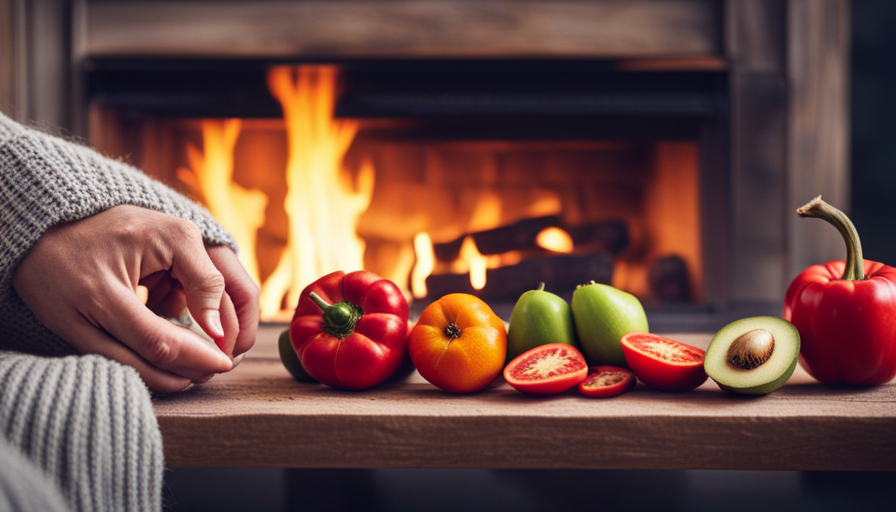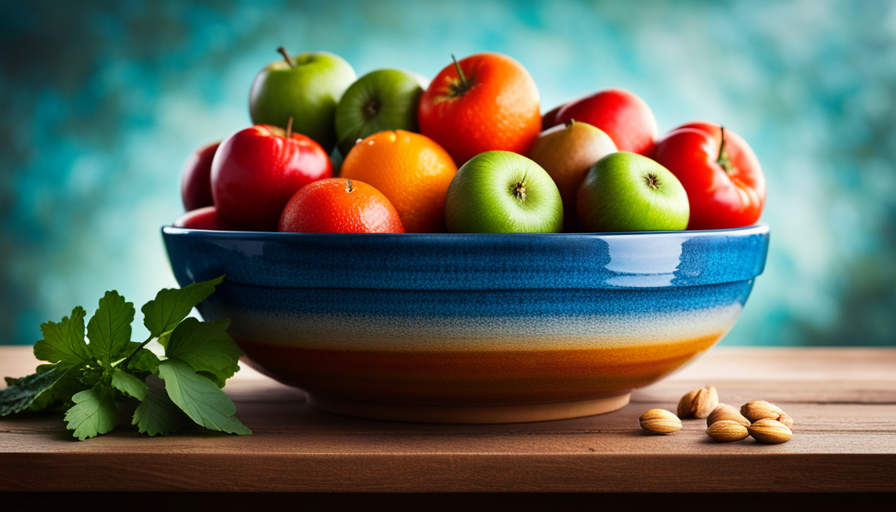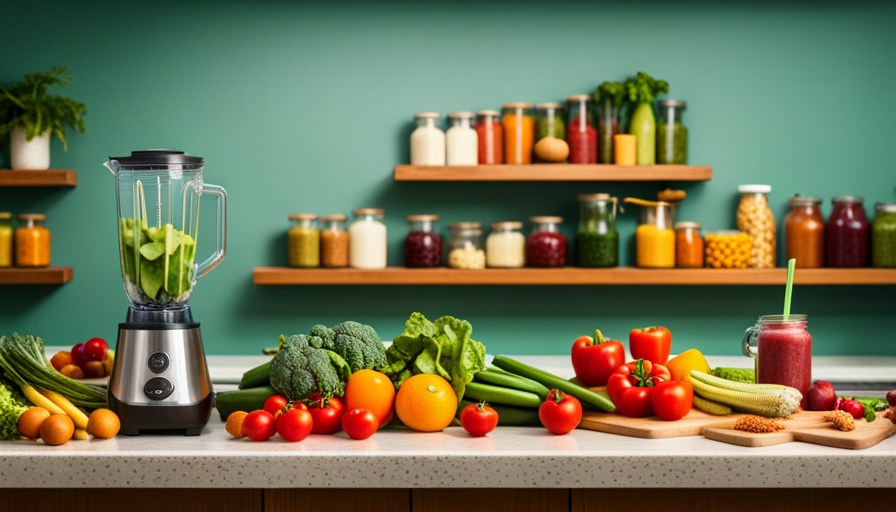You have decided to embark on a culinary adventure and explore the world of raw cuisine. Raw food living has gained popularity for its potential health benefits and vibrant flavors it offers.
But what happens when you want to add a little heat to your raw meals? Heating raw food can be a bit of a paradox, as the whole point of a raw food diet is to consume uncooked ingredients. However, there are times when heating certain raw foods can enhance their taste and texture, or even make them safer to eat.
In this article, we will guide you through the process of safely heating raw food, from understanding the risks involved to choosing the right heating methods and monitoring temperatures for food safety.
So let’s dive in and learn how to heat raw food the right way!
Key Takeaways
- Proper heating of raw food is essential for enhancing taste, texture, and safety.
- Cross-contamination can occur if raw food comes into contact with cooked or ready-to-eat food.
- Perishable raw food should be stored in the refrigerator below 40°F (4°C).
- Monitoring temperature with a food thermometer is crucial for ensuring food reaches safe internal temperatures.
Understanding the Risks of Heating Raw Food
When heating raw food, it’s important to understand the risks involved and take necessary precautions.
Common foodborne illnesses can occur if raw food is not handled properly during the heating process. These illnesses can range from mild gastrointestinal discomfort to severe complications that require medical attention.
One of the most important aspects of proper food handling is ensuring that raw food is heated to the appropriate temperature. This is crucial because heat helps to kill bacteria and other pathogens that may be present in the food. It’s recommended to use a food thermometer to ensure that the internal temperature of the food reaches the recommended safe zone.
Another risk to consider when heating raw food is cross-contamination. This can occur when raw food comes into contact with cooked or ready-to-eat food, leading to the transfer of bacteria or other harmful microorganisms. To prevent this, it’s important to keep raw food separate from other food items and to clean and sanitize all utensils and surfaces that come into contact with raw food.
By understanding the risks associated with heating raw food and following proper food handling practices, you can help ensure the safety of your meals. Taking these necessary precautions will greatly reduce the risk of foodborne illnesses and allow you to enjoy your food without worry.
Proper Food Handling and Storage
Properly preserving perishable produce promotes prolonged freshness. When it comes to handling and storing raw food, following safe techniques is crucial to avoid foodborne illnesses. Here are three key guidelines to ensure proper food storage and handling:
-
Keep it cool: Store perishable raw food, such as meat, poultry, and dairy products, in the refrigerator at a temperature below 40°F (4°C). This helps slow down the growth of bacteria that can cause food poisoning.
-
Separate and conquer: To prevent cross-contamination, keep raw meats away from other foods, especially those that won’t be cooked, like salads or fruits. Use separate cutting boards, utensils, and plates for raw and cooked foods to avoid the transfer of harmful bacteria.
-
Time matters: Remember to discard any raw food that has been left at room temperature for more than two hours. Bacteria multiply rapidly at room temperature, increasing the risk of foodborne illness. If the temperature is above 90°F (32°C), discard the food after just one hour.
By following these proper food storage and safe handling techniques, you can minimize the risk of foodborne illnesses and enjoy your meals with peace of mind.
Choosing the Right Heating Methods
The right heating methods can make all the difference in how your meals turn out. When it comes to safely heating raw food, there are a few key considerations to keep in mind.
First, you need to determine the appropriate heating time for the specific food you’re preparing. Different types of raw food require different amounts of time to heat thoroughly. It’s important to follow recommended cooking times to ensure that harmful bacteria are eliminated and the food is safe to eat.
Next, choosing the right cooking utensils is crucial for safe heating. Nonstick pans are great for cooking delicate foods, as they prevent sticking and require less oil. Stainless steel pans are perfect for searing and browning meats, as they can withstand high heat. Cast iron pans are excellent for even heat distribution and can be used for a variety of cooking methods. It’s important to select the appropriate utensil for the type of food you’re heating to ensure that it cooks evenly and thoroughly.
By following these guidelines for heating raw food, you can enjoy delicious and safe meals every time. Remember to always follow recommended cooking times and choose the right utensils for the job. Happy cooking!
Monitoring Temperature for Food Safety
Monitoring temperature is essential for ensuring that your meals are cooked to perfection and free from any potential risks. Proper temperature control is crucial in preventing foodborne illnesses and ensuring that harmful bacteria are killed. Here are three important reasons why monitoring temperature is vital for food safety:
-
Bacteria control: By monitoring the temperature, you can effectively control the growth of bacteria. Harmful bacteria, such as Salmonella and E. coli, thrive in temperatures between 40°F (4°C) and 140°F (60°C). Keeping your food at temperatures outside of this danger zone will help prevent bacteria from multiplying and causing food poisoning.
-
Cooking accuracy: Different types of food require specific internal temperatures to be considered safe for consumption. Using a food thermometer allows you to accurately measure the internal temperature of your food, ensuring that it reaches the appropriate level to kill any bacteria present. This is especially important for raw meats, poultry, and seafood, as they can carry harmful pathogens.
-
Quality assurance: Monitoring temperature not only ensures food safety but also guarantees the quality of your meals. Undercooking can lead to unpleasant textures and flavors, while overcooking can result in dry and tasteless dishes. By consistently monitoring the temperature, you can achieve the perfect balance between food safety and great taste.
By prioritizing temperature monitoring, you can enjoy delicious, safe meals without the risk of foodborne illnesses.
Avoiding Cross-Contamination
To ensure the integrity of your meals, it’s crucial to prioritize avoiding cross-contamination like a meticulous chef separating the flavors of a dish. Preventing contamination and practicing safe food handling are essential when heating raw food. Cross-contamination can occur when harmful bacteria from one food item is transferred to another, leading to foodborne illnesses.
Here are some tips to help you avoid cross-contamination and keep your meals safe.
Firstly, always wash your hands thoroughly with soap and warm water before and after handling raw food. This simple step can prevent the spread of bacteria from your hands to the food. Additionally, make sure to clean and sanitize all utensils, cutting boards, and countertops after each use.
When preparing raw food for heating, it’s important to keep it separate from ready-to-eat foods. Use separate cutting boards and knives for raw meat, poultry, and seafood to prevent cross-contamination. Raw juices from these foods can contain harmful bacteria, so it’s crucial to handle them carefully.
Another way to prevent cross-contamination is to store raw food properly in the refrigerator. Keep raw meat, poultry, and seafood in sealed containers or plastic bags to prevent their juices from dripping onto other foods. Place them on the bottom shelf to avoid any leakage onto other items.
By following these guidelines and practicing safe food handling, you can ensure that your meals are free from cross-contamination and safe to eat. Remember, a little extra effort in preventing cross-contamination goes a long way in keeping you and your loved ones healthy.
Maintaining Nutritional Value while Heating
Get the most out of your meals by ensuring the nutritional value remains intact while you warm them up. Maintaining nutrient density, as well as preserving enzymes and antioxidants, is crucial when heating raw food. These elements are essential for our overall health and well-being. To help you understand how different heating methods affect the nutritional value of your food, let’s take a look at the following table:
| Heating Method | Nutrient Loss | Enzyme Preservation | Antioxidant Preservation |
|---|---|---|---|
| Microwave | Low | Low | High |
| Steaming | Low | High | High |
| Oven | Moderate | Moderate | Moderate |
| Stovetop | High | Low | Low |
As you can see, microwaving your food is the best option for preserving antioxidants, but it may result in some nutrient loss. On the other hand, steaming is a great method for maintaining nutrient density and preserving enzymes and antioxidants. The oven and stovetop methods are not as effective in preserving these elements.
When heating your raw food, it’s important to choose a method that aligns with your nutritional goals. Consider steaming or microwaving for optimal nutrient retention. Additionally, remember to heat your food gently and avoid overcooking to minimize nutrient loss. By taking these steps, you can ensure that your meals remain both delicious and nutritious.
Incorporating Cooked Ingredients into Raw Meals
Embrace the transformative power of fire as you infuse your raw meals with the warmth and richness of cooked ingredients, elevating their flavors and textures to new heights. Incorporating cooked ingredients into raw meals can add depth and complexity to your dishes while still maintaining the nutritional value of the raw ingredients. Here are five ways to incorporate cooked ingredients into your raw meals:
-
Roast vegetables: By roasting vegetables like sweet potatoes or peppers, you can bring out their natural sweetness and add a smoky flavor to your raw salads or wraps.
-
Sautéed mushrooms: Sautéing mushrooms in a bit of olive oil can enhance their earthy flavor and create a savory component for your raw dishes.
-
Grilled tofu: Grilling tofu adds a charred and crispy texture, making it a delicious addition to raw stir-fries or grain bowls.
-
Poached eggs: Adding a perfectly poached egg to your raw vegetable bowl can provide a creamy and rich element that complements the freshness of the raw ingredients.
-
Caramelized onions: Caramelized onions bring a sweet and savory flavor to any dish. They can be added to raw meals like salads or wraps to provide a burst of flavor.
By incorporating these cooked ingredients into your raw meals, you can create a balance of flavors and textures that will take your dishes to the next level. Experiment with these techniques and let your creativity shine in the kitchen!
Using Food Thermometers for Accuracy
Using a food thermometer ensures that your meals are cooked to perfection, guaranteeing both taste and safety. When it comes to heating raw food, using digital thermometers is essential for accuracy.
These thermometers provide precise temperature readings, allowing you to determine if your food has reached the proper internal temperature. To use a digital thermometer, simply insert the probe into the thickest part of the food, making sure it doesn’t touch bone or fat. Wait a few seconds for the temperature to stabilize, and then read the display.
It’s important to calibrate your food thermometer regularly to ensure its accuracy. To calibrate, fill a glass with ice and water, and then insert the probe into the mixture. The thermometer should read 32°F (0°C). If it doesn’t, consult the manufacturer’s instructions for calibration.
By using a properly calibrated digital thermometer, you can have peace of mind knowing that your food is cooked to the right temperature, reducing the risk of foodborne illnesses.
So, make sure to always have a food thermometer handy in your kitchen to ensure your meals are both delicious and safe.
Safe Heating Techniques for Different Types of Raw Foods
Mastering the art of handling various types of ingredients is crucial for achieving perfectly cooked meals every time. When it comes to heating raw foods, it’s important to follow safe techniques to ensure they’re cooked thoroughly and free from harmful bacteria. Here are some tips for safely heating different types of raw foods:
-
Heating Vegetables:nn1. Blanching: This technique involves briefly boiling vegetables and then plunging them into ice water. It helps preserve their color, texture, and nutrients.nn2. Steaming: Steaming vegetables is a gentle yet effective way to cook them. It retains their natural flavors and nutrients while ensuring they’re thoroughly cooked.nn3. Roasting: Roasting vegetables in the oven at a high temperature brings out their natural sweetness and enhances their flavors. It also gives them a slightly crispy texture.
-
Cooking Meat:nn1. Grilling: Grilling meat not only gives it a delicious smoky flavor but also helps cook it evenly. Remember to use a food thermometer to ensure the meat reaches the recommended internal temperature.nn2. Searing: Searing meat on high heat helps lock in the juices and creates a flavorful crust. Finish cooking it in the oven or on the stovetop to ensure it’s fully cooked.nn3. Braising: Braising involves cooking meat slowly in a liquid, such as broth or wine. This method helps tenderize tough cuts of meat and infuses them with rich flavors.
By following these safe heating techniques, you can ensure your vegetables are cooked to perfection and your meat is safe to eat.
Tips for Reheating Leftover Raw Meals
Reheating leftover meals can be a game-changer for enjoying a delicious and convenient meal without the hassle of cooking from scratch. However, it’s important to follow proper reheating techniques to ensure that the food is safe to eat and to prevent the risk of foodborne illness.
To start, make sure to reheat the leftover raw meal thoroughly. This means heating it to an internal temperature of 165°F (74°C) to kill any bacteria that may be present. Use a food thermometer to check the temperature and ensure it reaches the safe zone.
When reheating, avoid using the microwave on low power settings as this can lead to uneven heating and increase the risk of bacteria growth. Instead, use the microwave on high power or opt for other methods such as stovetop or oven reheating, which provide more even heat distribution.
It’s also essential to cover the food while reheating to help retain moisture and prevent it from drying out. Use a microwave-safe lid or cover the dish with microwave-safe plastic wrap, leaving a small vent for steam to escape.
Lastly, remember to stir or rotate the food halfway through the reheating process to promote even heating and avoid cold spots.
By following these reheating techniques, you can safely enjoy your leftover raw meals without compromising your health. Stay knowledgeable and detail-oriented in your approach to prevent any foodborne illness.
Frequently Asked Questions
Can I safely heat raw meat in the microwave?
Yes, you can safely heat raw meat in the microwave. The microwave is a convenient and efficient heating method for raw meat. However, it’s important to follow proper food safety guidelines. Make sure to place the meat on a microwave-safe dish and cover it to prevent splatters. Use a meat thermometer to ensure the internal temperature reaches the recommended level to kill any harmful bacteria.
Always handle raw meat with clean hands and clean all utensils and surfaces thoroughly to avoid cross-contamination.
How long can I store raw vegetables in the refrigerator before heating them?
You can store raw vegetables in the refrigerator for about 3-5 days before heating them. Just like a fresh bouquet of flowers wilting over time, raw vegetables also have a shelf life.
To maintain their freshness, store them in a sealed plastic bag or container in the refrigerator’s vegetable drawer. Remember to wash them before storing, as this helps eliminate any dirt or bacteria that may be present.
Is it safe to eat raw eggs if I heat them in a recipe?
It’s safe to eat raw eggs if you heat them in a recipe, as long as they reach the appropriate temperature. Cooking techniques like baking, boiling, or frying can effectively heat raw eggs, eliminating any potential bacteria.
However, it’s important to note that heating eggs may slightly reduce their nutritional value, particularly in terms of their vitamin and antioxidant content. Nonetheless, it’s still a safe and popular method of preparing eggs in various recipes.
Can I use a slow cooker to heat raw seafood?
To safely heat raw seafood, it’s not recommended to use a slow cooker. A slow cooker is great for vegetables, but seafood requires higher heat to ensure thorough cooking and to avoid foodborne illnesses. Instead, consider alternative methods like grilling, broiling, or steaming.
These methods will provide the necessary heat to cook the seafood properly while preserving its flavor and texture.
What temperature should I heat raw dairy products to ensure safety?
To ensure the safety of raw dairy products, it’s recommended to heat them at a temperature of at least 165°F (74°C). This temperature kills harmful bacteria that may be present in the raw dairy.
You can use various heating methods such as stovetop, microwave, or oven. The recommended heating time for raw dairy products varies depending on the method used, but generally, heating for 5-10 minutes should be sufficient to reach the desired temperature and ensure safety.
Is it Safe to Heat Raw Food for Consumption?
When it comes to heating raw food techniques, safety is crucial. While some raw foods may benefit from light heating, it’s important to ensure that they are thoroughly cooked to kill any harmful bacteria before consumption. Use caution and follow recommended guidelines to safely heat raw food for consumption.
Conclusion
In conclusion, heating raw food safely is crucial to prevent foodborne illnesses. By understanding the risks, following proper food handling and storage practices, choosing the right heating methods, monitoring temperature, and avoiding cross-contamination, you can ensure the safety of your meals.
Incorporating cooked ingredients into raw meals and using food thermometers for accuracy are also important techniques to consider. Remember, reheating leftover raw meals requires special attention. So, why take risks with your health when you can enjoy delicious and safe meals by following these guidelines?
Stay informed and protect yourself and your loved ones.

